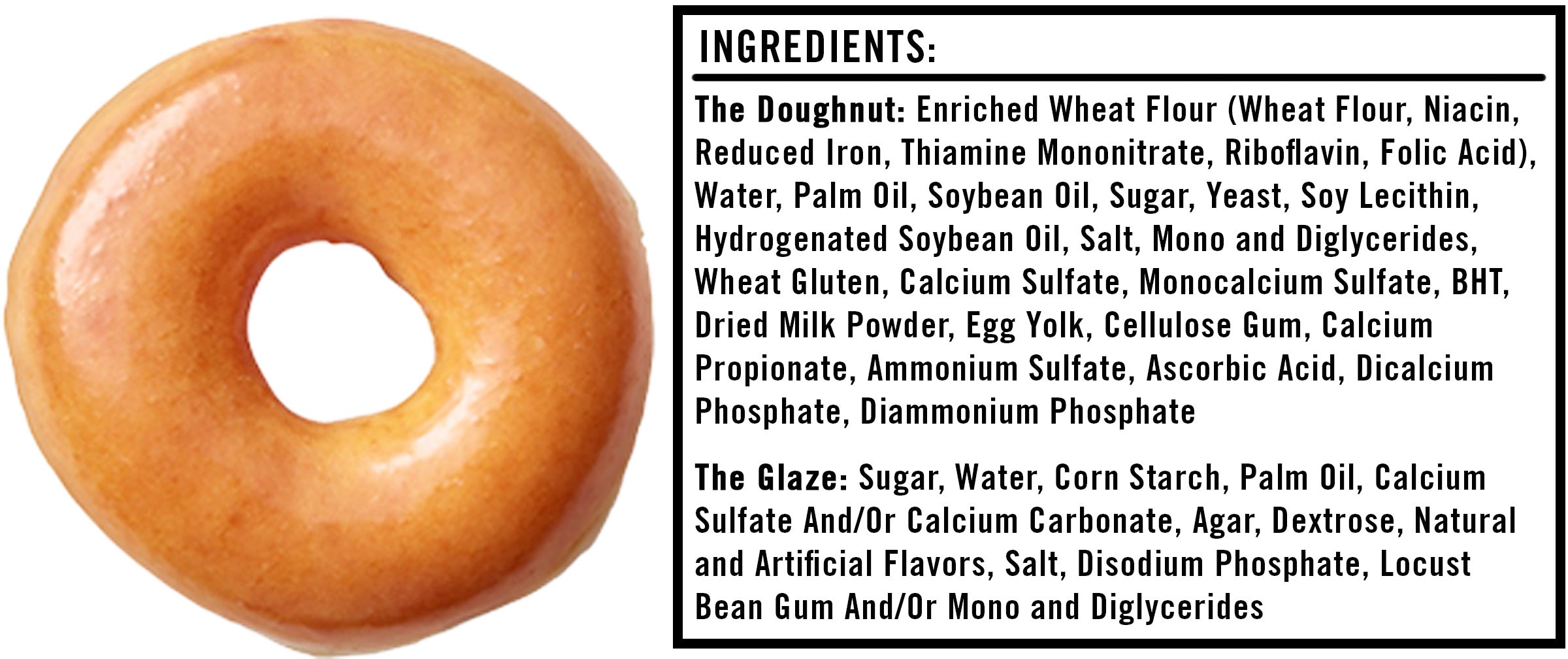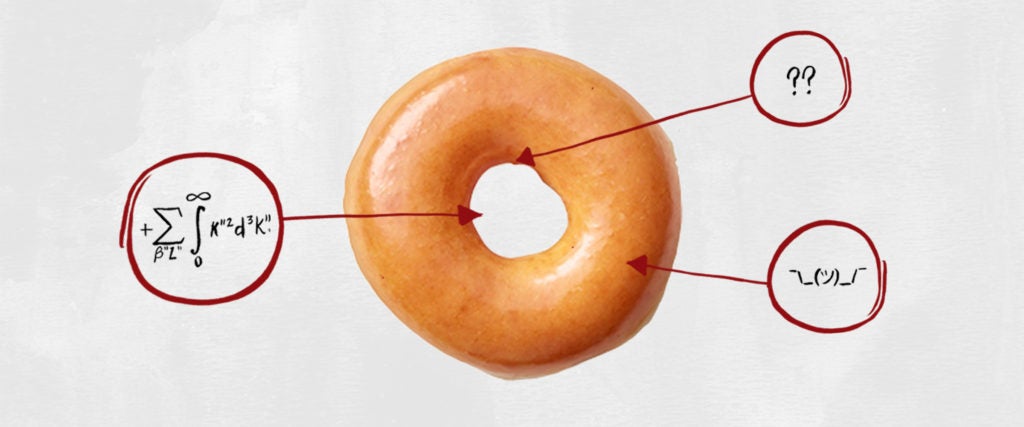We’re often told that you should never eat anything (or put anything on your body) if you don’t recognize everything on the ingredients list. But since most of us have no idea what xanthan gum or potassium benzoate are — or more importantly, what they’re doing to our bodies — we’re decoding the ingredients in the many things Americans put in (and on, or near) themselves.
This edition: Krispy Kreme Original Glazed Doughnuts, which are made from 33 separate ingredients that we’ve broken down in the exact order they appear online.

The Doughnut
1) Enriched Wheat Flour (Wheat Flour, Niacin, Reduced Iron, Thiamine Mononitrate, Riboflavin, Folic Acid): As we learned in our exploration of the many, many, many ingredients in the McDonald’s Big Mac, enriched flour isn’t actually “enriched” at all. In addition to containing more calories than whole wheat flour, the bleaching process enriched flour often undergoes can produce an unfortunate byproduct: A chemical called alloxan, which has been found to induce diabetes in lab-animal test subjects by destroying their pancreas.
2) Water: In doughnut making, water is combined with yeast to make dough.
3) Palm Oil: Many major doughnut retailers, Krispy Kreme included, have a history of frying their products in palm oil or a blend that contains palm oil. Unfortunately, consumed in large amounts, palm oil can cause all sorts of problems, including fatty liver disease, insulin resistance and migraines. Double unfortunately, the sourcing of palm oil is awful for the environment. This is why Krispy Kreme and other leading doughnut producers have pledged to move toward deforestation-free palm oil. But in an ideal world, they’d use something else entirely.
4) Soybean Oil: While soybean oil isn’t as notoriously bad for the environment as palm oil, the same concerns apply.
5) Sugar: One glazed doughnut contains 10 grams of sugar, which can certainly add up, but is still a reasonable amount relative to, say, the 61 grams in a Starbucks frappuccino. For reference, the American Heart Association recommends men consume no more than 36 grams and women consume no more than 25 grams of added sugar per day.
6) Yeast: Yeast is the fungus that makes dough rise.
7) Soy Lecithin: Soy lecithin is a component of fat found in — you guessed it — soy. It’s typically added to food products as an emulsifier, which means it helps the numerous ingredients in these doughnuts mix together. “It’s also frequently used to extend product shelf life,” Dagan Xavier, ingredient expert and co-founder of Label Insight, told me during our analysis of the ingredients in frozen breakfast sandwiches.
8) Hydrogenated Soybean Oil: Soybean oil might be kinda bad, but hydrogenated soybean oil is worse. When you add hydrogen to food via hydrogenation, which many manufactures do to increase its shelf life, you get trans fats. Unfortunately, trans fats raise cholesterol, harden arteries and inhibit the formation of an enzyme called cyclooxygenase, which otherwise helps determine the dilation of your arteries and regulates blood flow. So watch out for this ingredient.
9) Salt: Each doughnut contains only a small sprinkling of salt to enhance its flavor.
10) Mono and Diglycerides: Mono (aka, monoglycerides) and diglycerides are dough conditioners added to improve the texture or quality of dough. Like hydrogenated soybean oil, they’re often packed with trans fats that aren’t listed on the nutrition facts label, which is incredibly problematic: Because trans fats are associated with an increased risk of heart disease, stroke and diabetes, consuming more than you think you are (because they weren’t listed on the label) could do serious damage to your body.
11) Wheat Gluten: Those with celiac disease beware: Wheat gluten is wheat flour that’s been hydrated to activate the gluten, then processed to remove everything but the gluten. It’s added to improve the chewiness of the doughnut.
12) Calcium Sulfate: Calcium sulfate is added to stabilize foods and regulate their acidity levels. It can also be used as a flour treatment agent to increase the speed of dough rising and to improve the strength and workability of the dough. In the amounts typically found in food, calcium sulfate isn’t likely to cause adverse effects and is generally regarded as safe by the FDA.
13) Monocalcium Sulfate: In baked goods, monocalcium phosphate can produce carbon dioxide, which helps the dough rise. When consumed in moderation, this ingredient isn’t anything to worry about. That said, an excessive amount of phosphates in the diet, particularly when contained in processed foods like Krispy Kreme doughnuts, can accelerate the aging process, increase the risk of heart disease and place undue stress on the kidneys.
14) BHT: BHT is a common preservative added to prevent products from spoiling. Studies continue to go back and forth about whether or not it’s carcinogenic, but it’s probably worth avoiding when possible.
15) Dried Milk Powder: In addition to providing some protein, the fats in dried milk powder can result in a more tender doughnut overall.
16) Egg Yolks: Egg yolks create a richer doughnut.
17) Cellulose Gum: Cellulose gum is a common thickening agent, and consuming large amounts of it may add bulk to your stool and have a laxative effect, according to the FDA. So, uh, if you experience a surge in toilet time after downing some Krispy Kreme doughnuts, you now know why.
18) Calcium Propionate (To Maintain Freshness): Another contributor to these doughnut’s long shelf-life, calcium propionate is an antifungal added to many bread products to prevent mold growth. In addition to being linked to migraines, a 2002 study in the Journal of Paediatric Child Health found that chronic exposure to calcium propionate in children caused irritability, restlessness, inattention and sleep disturbance. So if you have a kid, maybe limit their Krispy Kreme consumption.
19) Ammonium Sulfate: In baking, ammonium sulfate is used as a dough conditioner and dough strengthener. While manufacturers claim it’s safe in small amounts, this ingredient can also be found in fertilizers, and studies show that exposure to high levels of ammonium sulfate can result in respiratory failure, so beware of foods that contain it.
20) Ascorbic Acid: Ascorbic acid is just another name for vitamin C. It’s used as yet another preservative.
21) Dicalcium Phosphate: Dicalcium phosphate is another leavening agent and acts as a calcium supplement in some prepared foods. It should pose you no real problems in this case, although remember: Too many phosphates in your diet can be a bad thing.
22) Diammonium Phosphate: This is yet another leavening agent that essentially speeds up the process.
The Glaze
1) Sugar: See above.
2) Water: See above.
3) Corn Starch: In this case, corn starch acts as a thickening agent. Without it, the glaze would be a liquidy mess.
4) Palm Oil: See above.
5) Calcium Sulfate and/or Calcium Carbonate: In addition to lending a glossy white color to the glaze, these calcium supplements can act as firming agents, which help it hold its shape atop the doughnut.
6) Agar: Agar is a vegetarian gelatin substitute made from seaweed, and it makes the glaze more firm.
7) Dextrose: Dextrose is a sugar derived from starches, like corn. In baking, dextrose is often used to control the crystallization of icings and glazes.
Fun fact: Dextrose has a high glycemic index, meaning it quickly raises blood sugar levels, so it’s used in IV solutions to treat low blood sugar and dehydration. People with diabetes might also consume dextrose tablets to raise their blood sugar if they become dangerously low. Because of this blood-sugar-boosting effect, consuming dextrose also provides an almost immediate jolt of energy — followed by an inevitable crash.
8) Natural and Artificial Flavors: While natural flavors are literally flavors derived from an actual food source — i.e., vanilla flavoring taken from a vanilla bean plant — artificial flavors are chemical compounds created in a lab that mimic a natural flavor in some way. While that may sound unhealthy, as physician and biochemist Cate Shanahan, author of Deep Nutrition: Why Your Genes Need Traditional Food, told us during our exploration of the ingredients in nacho-flavored Doritos, these flavorings are added in such small quantities that they shouldn’t cause you any harm.
9) Salt: See above.
10) Disodium Phosphate: Disodium phosphate is a combination of the minerals phosphorus and sodium. In powdered products, it acts as an anti-caking agent, preventing the powder from clumping together, which in this case results in a smoother glaze.
11) Locust Bean Gum And/Or Mono and Diglycerides: We already covered mono and diglycerides, but locust bean gum is a natural food additive derived from carob seeds. It’s used primarily as a thickening and stabilizing agent.
The Takeaway
It seems as though Krispy Kreme has figured out the ultimate, ultra-processed doughnut, using every ingredient they can think of to ensure doughnut perfection. The result is a truly addictive doughnut, no doubt, but one that contains more than just a handful of questionable ingredients. That said, no doughnut is particularly healthy, and so long as you keep moderation in mind, the occasional Krispy Kreme isn’t going to kill you (right away).

